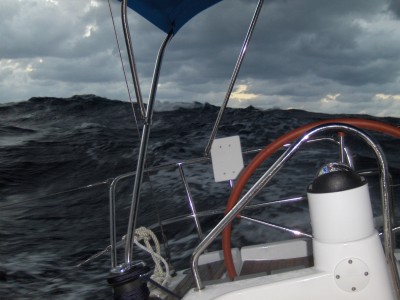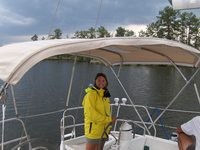
Voyages of Cour Volant
02 December 2008 | Tortola BVI
28 August 2008 | Oriental NC
18 June 2008 | Oriental NC
Another sucessful voyage
02 December 2008 | Tortola BVI

After delays getting out of Charleston, SC, the new charter built Jeanneau 393 was ready to set sail. Many people ask me, especially those that are traditionalists why I would take such a lightly built boat offshore and was I apprehensive about it. My usual answer is that since the boat is brand new and is a tested design I am normally comfortable. Of course there are always little things that need to be addressed along the way, but most times we get there just fine.
I've recently experienced more heavy weather aboard these light modern boats and would like to add my thoughts to their handling in such conditions.
Our old standby heavy weather sailing books were written in a time of more heavily displacement, solid fiberglass hulls were being built in the 60-80's. These techniques are solid and I would not hesitate to employ them on such a boat in heavy conditions. But our modern boats, some of which are very light, behave a little differently but can be just as safe an any old seafaring hull from the early days of fiberglass.
Benefits of modern boat design. First of all these boats are fast. My most recent experience involved a gale in the Atlantic off the coast of the Bahamas. We had called our weather router about an impending low coming off the east coast. He instructed us to change course and make way to a way point almost due south to get out of the worst of the storm. On a beam reach we were able to sail a little less than 200 miles south in a 24 hour period and did not suffer the worst of the gale. Our 39 footer averaged 7.5 knots. In this case our lighter displacement translated in speed to safety, which I consider a positive.
Another positive aspect to modern light displacement boats is buoyancy. Those of you that have ever been caught side to a big wave know what I'm talking about. In my old heavy displacement boat, that sit stoutly in the water, we would get very wet, roll a good deal and would do everything not to get caught beam on to a sea.
The modern boats I tend to deliver offshore have no problem taking a beam sea. Even a steep 15 foot swell never knocks her on her ear, since the boat is so buoyant. Running we almost never get pooped since the light transom is just lifted over the crest. And if a wave does catch us from behind the open transom lets the water exit very quickly and does not depend on scuppers, that may get clogged, to exit the water flow.
Things to consider and watch out for. Watch your sail area, since these boats are so light, you need to reef and reef often. I have found that on the charter built boats that we deliver offshore that the slab reefing system is set up with two, very shallow reef points. This is perfectly adequate for trade wind sailing, like the conditions in the Caribbean but causes problems in dealing with heavy weather offshore. Even though for years I dogged the stow away mainsails that have become so popular, now that I own a boat with one I not only appreciate the benefits and safety but love the nearly endless options available in order to balance out the boat in any wind conditions. Where as the decision to reef on our traditionally rigged boat comes with much anxiety, along with the anxiety and risk of dousing the sail from having to go forward. Of course most of these times happen at night and in worsening conditions so the entire crew is awakened and suited up for the task. Offshore single handing on CourVolant is made much simpler by just rolling in the main to the desired level. It takes less than a minute, is done from the complete safety of the cockpit and the crew never looses a minute of much needed sleep. And since I can stow the main to almost any degree, the boat stays more balanced and thus handles wind and wave much better, staying on her feet more redly. I have never had any problems with the never systems in rolling the sails in. The only problem I have had is in rolling them out but that is due to the furling line either swelling or chafing in the drum, which can be eliminated by using a better quality and sometimes smaller diameter line.
What if things get really bad. Another voyage we had on a 41' Beneteau in storm force winds off the coast of Cuba we had steep short period swell of over 25 feet. The boat and auto pilot where not coming into sync with the conditions and our mainsail was unable to be doused. After hours hand steering and nearing exhaustion we decided to employ a technique called Forereaching, and it worked brilliantly. We let out just a scarp of the genoa and turned the boat about 15-25 degrees off the wind. The auto pilot was able to hold that course with ease making about 2 knts under about 1000 rpm of the engine. The boat instantly quieted down and we were able to head below and actually play cards and have a much need meal.
I would employ this strategy any time that the wind and sea conditions were not conducive to making way.
The moral of this story is always to avoid any dangerous conditions in any boat but the modern boat has some nice benefits if you do happen to be caught unaware. The ride may not be as gentlemanly as in our older heavy displacement boats but its not too bad and the extra speed will get you to your destination that much faster.
Happy passagemaking.
I've recently experienced more heavy weather aboard these light modern boats and would like to add my thoughts to their handling in such conditions.
Our old standby heavy weather sailing books were written in a time of more heavily displacement, solid fiberglass hulls were being built in the 60-80's. These techniques are solid and I would not hesitate to employ them on such a boat in heavy conditions. But our modern boats, some of which are very light, behave a little differently but can be just as safe an any old seafaring hull from the early days of fiberglass.
Benefits of modern boat design. First of all these boats are fast. My most recent experience involved a gale in the Atlantic off the coast of the Bahamas. We had called our weather router about an impending low coming off the east coast. He instructed us to change course and make way to a way point almost due south to get out of the worst of the storm. On a beam reach we were able to sail a little less than 200 miles south in a 24 hour period and did not suffer the worst of the gale. Our 39 footer averaged 7.5 knots. In this case our lighter displacement translated in speed to safety, which I consider a positive.
Another positive aspect to modern light displacement boats is buoyancy. Those of you that have ever been caught side to a big wave know what I'm talking about. In my old heavy displacement boat, that sit stoutly in the water, we would get very wet, roll a good deal and would do everything not to get caught beam on to a sea.
The modern boats I tend to deliver offshore have no problem taking a beam sea. Even a steep 15 foot swell never knocks her on her ear, since the boat is so buoyant. Running we almost never get pooped since the light transom is just lifted over the crest. And if a wave does catch us from behind the open transom lets the water exit very quickly and does not depend on scuppers, that may get clogged, to exit the water flow.
Things to consider and watch out for. Watch your sail area, since these boats are so light, you need to reef and reef often. I have found that on the charter built boats that we deliver offshore that the slab reefing system is set up with two, very shallow reef points. This is perfectly adequate for trade wind sailing, like the conditions in the Caribbean but causes problems in dealing with heavy weather offshore. Even though for years I dogged the stow away mainsails that have become so popular, now that I own a boat with one I not only appreciate the benefits and safety but love the nearly endless options available in order to balance out the boat in any wind conditions. Where as the decision to reef on our traditionally rigged boat comes with much anxiety, along with the anxiety and risk of dousing the sail from having to go forward. Of course most of these times happen at night and in worsening conditions so the entire crew is awakened and suited up for the task. Offshore single handing on CourVolant is made much simpler by just rolling in the main to the desired level. It takes less than a minute, is done from the complete safety of the cockpit and the crew never looses a minute of much needed sleep. And since I can stow the main to almost any degree, the boat stays more balanced and thus handles wind and wave much better, staying on her feet more redly. I have never had any problems with the never systems in rolling the sails in. The only problem I have had is in rolling them out but that is due to the furling line either swelling or chafing in the drum, which can be eliminated by using a better quality and sometimes smaller diameter line.
What if things get really bad. Another voyage we had on a 41' Beneteau in storm force winds off the coast of Cuba we had steep short period swell of over 25 feet. The boat and auto pilot where not coming into sync with the conditions and our mainsail was unable to be doused. After hours hand steering and nearing exhaustion we decided to employ a technique called Forereaching, and it worked brilliantly. We let out just a scarp of the genoa and turned the boat about 15-25 degrees off the wind. The auto pilot was able to hold that course with ease making about 2 knts under about 1000 rpm of the engine. The boat instantly quieted down and we were able to head below and actually play cards and have a much need meal.
I would employ this strategy any time that the wind and sea conditions were not conducive to making way.
The moral of this story is always to avoid any dangerous conditions in any boat but the modern boat has some nice benefits if you do happen to be caught unaware. The ride may not be as gentlemanly as in our older heavy displacement boats but its not too bad and the extra speed will get you to your destination that much faster.
Happy passagemaking.
Comments
| Vessel Name: | Cour Volant |
| Vessel Make/Model: | Jeanneau 40 |
| Hailing Port: | Oriental, NC |
| Crew: | Edana, Bret and Friends |
| About: |
Gallery not available

Who: Edana, Bret and Friends
Port: Oriental, NC